
The New York City Transit Police Department was a law enforcement agency in New York City that existed from 1953 to 1995, and is currently part of the NYPD. The roots of this organization go back to 1936 when Mayor Fiorello H. La Guardia authorized the hiring of special patrolmen for the New York City Subway. These patrolmen eventually became officers of the Transit Police. In 1949, the department was officially divorced from the New York City Police Department, but was eventually fully re-integrated in 1995 as the Transit Bureau of the New York City Police Department by New York City Mayor Rudy Giuliani.
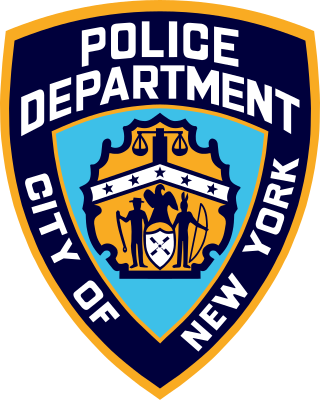
The New York City Police Department (NYPD), officially the City of New York Police Department, is the primary law enforcement agency within New York City. Established on May 23, 1845, the NYPD is the largest, and one of the oldest, municipal police departments in the United States.
The New York City Police Department Medal of Honor is the highest law enforcement medal of the New York City Police Department. The Medal of Honor is awarded for individual acts of extraordinary bravery performed in the line of duty at extreme risk and danger to life.
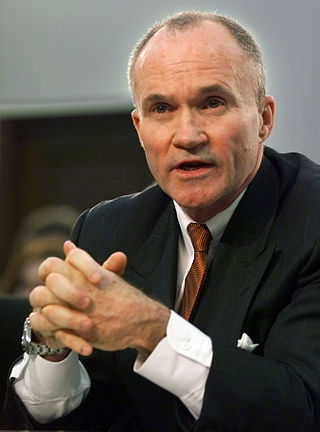
Raymond Walter Kelly is the longest-serving Commissioner in the history of the New York City Police Department (NYPD) and the first person to hold the post for two non-consecutive tenures. According to its website, Kelly, a lifelong New Yorker, had spent 45 years in the NYPD, serving in 25 different commands and as Police Commissioner from 1992 to 1994 and again from 2002 until 2013. Kelly was the first man to rise from Police Cadet to Police Commissioner, holding all of the department's ranks, except for Three-Star Bureau Chief, Chief of Department and Deputy Commissioner, having been promoted directly from Two-Star Chief to First Deputy Commissioner in 1990. After his handling of the World Trade Center bombing in 1993, he was mentioned for the first time as a possible candidate for FBI Director. After Kelly turned down the position, Louis Freeh was appointed.

The New York City Police Department Auxiliary Police is a volunteer reserve police force which is a subdivision of the Patrol Services Bureau of the New York City Police Department. Auxiliary Police Officers assist the NYPD with uniformed patrols, providing traffic control, crowd control, and other services during major events.

Russel Timoshenko was a 23-year-old New York Police Department (NYPD) police officer who was shot on July 9, 2007, and died five days later, after pulling over a stolen BMW automobile in New York City's Crown Heights, Brooklyn, neighborhood. After a four-day manhunt that stretched across three states, all three suspects Dexter Bostic, Robert Ellis and Lee Woods were eventually apprehended and convicted—two of murder, and the third for weapons possession. At his widely attended funeral, Timoshenko was posthumously promoted to the rank of Detective. The case garnered national media attention because the weapons used were all illegally obtained handguns. This sparked widespread debate over gun control laws in New York City, and over the process by which firearms are traced by police departments.

The New York City Housing Authority Police Department was a law enforcement agency in New York City that existed from 1952 to 1995, which was then merged into the NYPD. The roots of this organization go back to 1934 and the creation of the New York City Housing Authority (NYCHA). New York City Mayor Fiorello H. La Guardia authorized the hiring of security guards to patrol the city's public housing buildings. These guards eventually were trained and became the first officers of the Housing Police, which was officially created in 1952. The Housing Police, along with the New York City Transit Police, was merged into the New York City Police Department in 1995 by New York City Mayor Rudy Giuliani and continues today as the Housing Bureau.

The Emergency Service Unit(ESU) is part of the Special Operations Bureau of the New York City Police Department. The unit provides specialized support and advanced equipment to other NYPD units. Members of ESU are cross-trained in multiple disciplines for police, first aid, and rescue work.

The New York City Police Department (NYPD) is structured into numerous bureaus and units. As a whole, the NYPD is headed by the Police Commissioner, a civilian administrator appointed by the Mayor, with the senior sworn uniformed officer of the service titled "Chief of Department". The Police Commissioner appoints the First Deputy Commissioner as the department's second-in-command and the Chief of Department as the department's highest ranking uniformed officer. The commissioner also appoints a number of deputy and assistant commissioners who do not have operational command and are solely for support and administrative function. The department is divided into twenty bureaus, six of which are enforcement bureaus. Each enforcement bureau is further subdivided into sections, divisions, and units, and into patrol boroughs, precincts, and detective squads. Each bureau is commanded by a bureau chief. There are also a number of specialized units that are not part of any of the bureaus and report to the Chief of the Department.
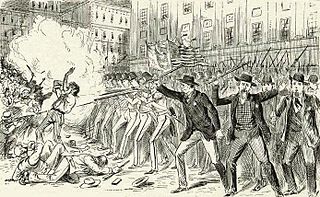
The New York City Police Department (NYPD) originates in the Government of New York City attempts to control rising crime in early- to mid-19th-century New York City. The City's reforms created a full-time professional police force modeled upon London's Metropolitan Police, itself only formed in 1829. Established in 1845, the Municipal Police replaced the inadequate night watch system which had been in place since the 17th century, when the city was founded by the Dutch as New Amsterdam.
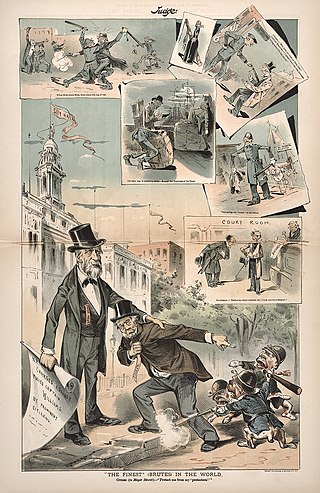
Throughout the history of the New York City Police Department, numerous instances of corruption, misconduct, and other allegations of such, have occurred. Over 12,000 cases have resulted in lawsuit settlements totaling over $400 million during a five-year period ending in 2014. In 2019, taxpayers funded $68,688,423 as the cost of misconduct lawsuits, a 76 percent increase over the previous year, including about $10 million paid out to two exonerated individuals who had been falsely convicted and imprisoned.
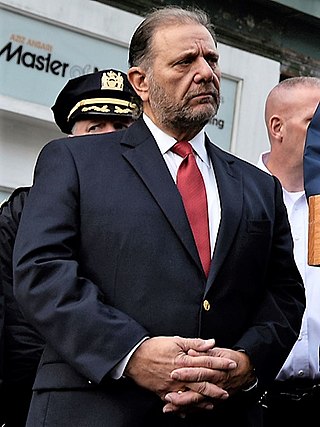
Joseph J. Esposito is a former law enforcement officer and civil servant. He is currently the Deputy Commissioner of Enforcement for the New York City Department of Buildings and formerly the Commissioner of New York City Emergency Management from June 27, 2014, until his controversial ousting in November 2018. Prior to that role he was the Chief of Department of the New York City Police Department (NYPD) from 2000 until his retirement from the NYPD in 2013.

The Detective Bureau is one of 20 bureaus that constitute the New York City Police Department and is headed by the three-star Chief of Detectives. The Detective Squad was formed in 1857 with the Detective Bureau later formed in 1882.

NYPD Chief of Patrol Nicholas Estavillo (Ret.), is a former member of the New York Police Department who in 2002 became the first Puerto Rican and the first Hispanic in the history of the NYPD to reach the three-star rank of Chief of Patrol.
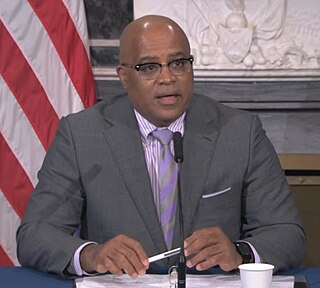
Philip Banks III is the current Deputy Mayor of New York City for Public Safety and a retired law enforcement officer who served as NYPD chief of department in 2013 and 2014. As chief of department, Banks oversaw all patrol and specialty units. His brother, David C. Banks, has been appointed as New York City Schools Chancellor.
Rafael Piñeiro is the former First Deputy Commissioner of the New York City Police Department (NYPD) and at that time the highest ranking Hispanic American member of the NYPD. In November 2013, he was rumored to be on Mayor-elect Bill de Blasio's short list to replace Ray Kelly as NYPD Commissioner.

Dermot Francis Shea is an American police officer who was the 44th New York City Police Commissioner. He assumed the position on December 1, 2019, and was sworn in by Mayor Bill de Blasio in a public ceremony on December 2.
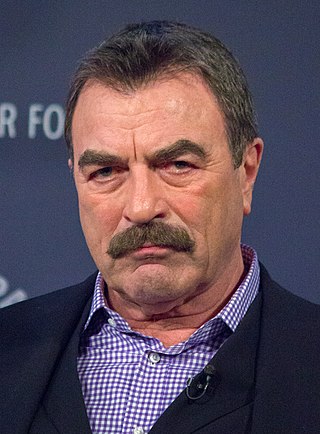
Francis Xavier Reagan is a fictional character from the TV series Blue Bloods portrayed by former Magnum, P.I. star Tom Selleck. In the series, Reagan is the New York City Police Commissioner, the son of a former Commissioner, and the patriarch of a family of police officers and others involved in aspects of the city's criminal justice system. Selleck's performance in the role has been critically praised, but the character has been criticized by some for presenting an overly positive view of law enforcement administration.

Keechant L. Sewell is an American police officer and administrator who served as the 45th New York City Police Commissioner, the first woman and third black person to serve in the position. On June 12, 2023, Sewell announced that she was stepping down as commissioner. No reason was given for her departure.
















